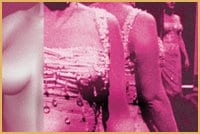Femme dykes and our supporters have ranted for at least 30 years about how femmes aren’t considered “real” dykes or queers. So it’s not like the ideas in Female to Femme are completely new. What audiences love is finally seeing them on film.
Directors Elizabeth Stark and Kami Chisholm combine an in-your-face celebration of femmes with a strong feminist slant that challenges anyone to forget what feminism has given queers.
Stark says it was important to come from a clearly feminist perspective. “A lot of people feel like they are ‘post-feminist.’ But feminism is not passé. It is radical. It is queer. It is cutting edge.”
Women in the film describe the evolution of lesbians’ and queers’ rejection of anything they perceived as mainstream feminine —like femme identity. As a result, many femmes made an effort to hide their femmeness.
Performer Toni Parks recalls trying to blend into “a sea of plaid flannel shirts as far as you can see, and everyone with the same butch haircut.” Actress Guinevere Turner remembers resisting her femmeness and “trying to have the trappings of dykiness to prove that I was gay to the general lesbian population.”
While the sea of plaid flannel probably dried up some time in the late ’80s and it became more commonly acknowledged that femme women really are lesbians too, we have now entered a new era. Both Stark and Chisholm emphasize that the film is in part a response to the queer community’s current obsession with and glorification of masculinity.
These days, butches, and even more so female-to-male trans people (FtMs), are held up as the true genderqueers, the true radicals. We have been inundated with documentaries and performances that explore and honour these identities.
Meanwhile, many queers assume that femmes are “natural born women,” and are simply proceeding along the path that they were set on at birth.
The filmmakers deliberately reference trans vocabulary —”female to femme” —to underline the fact that no one is born into their gender identity; everyone creates a gender identity, whether that identity is similar to or different from what society expects of us.
Chisholm hopes that using trans language will make people question the naturalizing of femmes —or, as she puts it, “anyone who isn’t butch or trans.”
Stark, a femme, says she identifies with trans folks: “People look at me and they don’t know who I am, because of what I look like on the outside.”
Leslie Mah, tattoo artist and guitarist for Tribe 8, talks about coming out to herself and then to others as femme, and learning to deal with people’s reactions. “Everyone has gender issues and when you come out as femme you’re going to trigger other people’s gender issues in a really big way.”
The women in the film make it clear that femme is queer. Bitch, describing her transition, says, “It was when I started dating women that I started going to the nth degree about being femme.”
Poet Meliza Bañales contrasts her femininity with her mother’s, which she believes was connected to a middle-class ideal of cleanliness and propriety: “My femininity is… dirty, complicated, ugly. And I like that.”
Stark says she wanted to challenge the conservative connotations of the word “feminine,” and highlight the queer and interesting ways that femmes are playing with femininity.
Female to Femme is full of articulate, beautiful and rebellious women, a welcome celebration of fat, skinny, black, white, Asian, tattooed, dreadlocked, lipstick-wearing femmes. I am more than willing to forgive its flaws, even though it has a couple.
Both Chisholm and Stark are academics, and the film gives a great deal of time to Masha Raskolnikov, a young femme prof at Cornell University who is fond of words like “performativity” and “iterate.” In a section of the film about passing as straight, we get just one heartfelt line from Toni Parks —”it really gets me, because I am so queer!” —and an extended theoretical monologue from Raskolnikov about the nature of identity and realness. The use of this language interrupts the intimacy and immediacy of the film, and also seems to assume a certain type of audience.
Still, the film ends with fabulous images of femmes and their supporters marching in San Francisco Pride. Stark remembers what a powerful experience it was to “intervene in our erasure” and claims that “female to femme is at the heart of the gender revolution.”
Her words echo Gomez’s claim at the beginning of the film that femmes are guerillas in the warfare for a feminist world.
I don’t know that I believe this or need it to be true. But what I do need, and am so fucking grateful for, is the film’s insistence on the right of femmes to claim a place in the queer community.

 Why you can trust Xtra
Why you can trust Xtra


